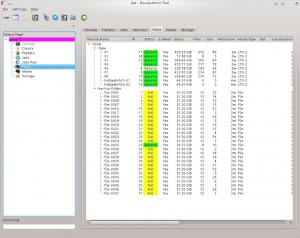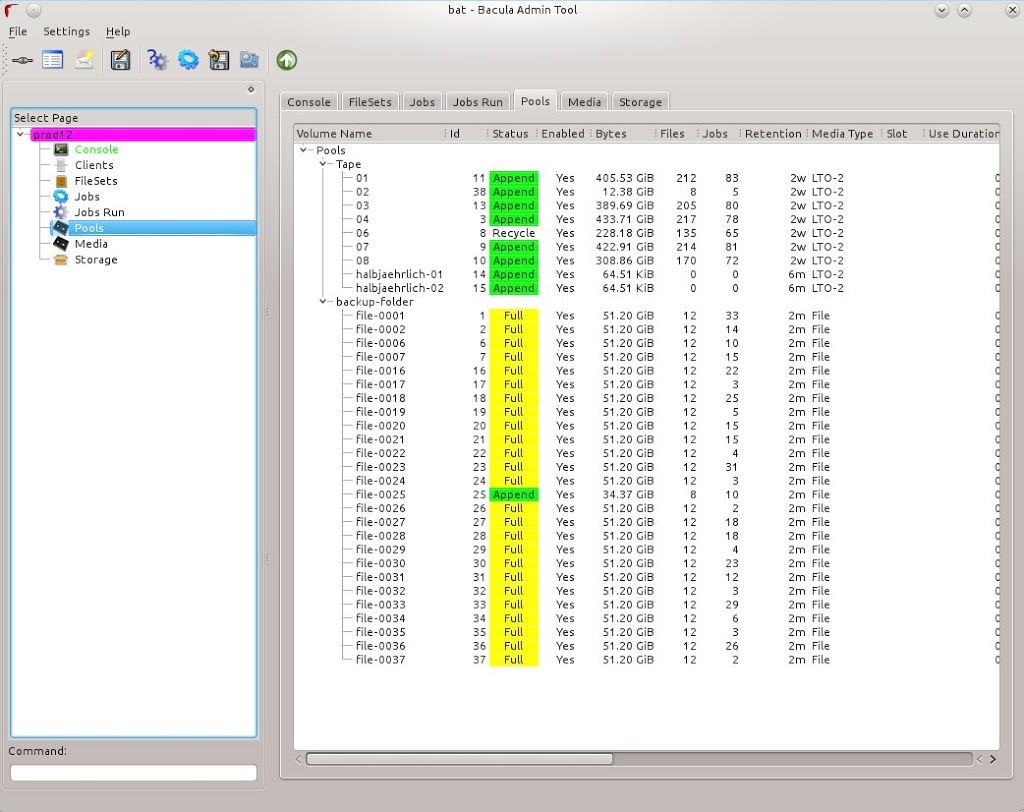Als vor einiger Zeit die alte Backup Lösung den Geist aufgegeben hat, habe ich mich nach einer neuen umgesehen. Auf der Suche nach einer guten und günstigen Backup Lösung bin ich dann auf Bacula gestoßen.
Aus Fachzeitschriften und vom Hörensagen war mir Bacula bereits bekannt, allerdings hatte ich noch nicht das Vergnügen Bacula zu installieren bzw. einzusetzen.
Das sollte sich aber ändern. 🙂
 Unser Bacula Server läuft inzwischen doch schon ein paar Monate und bis auf kleine Problemchen bei der Konfiguration so zuverlässig wie man es von einem Backup erwartet. Unterm Strich würde ich sogar sagen dass man durch die etwas schwere Konfiguration über Konfig-Dateien wesentlich mehr Einblick in das Geschehen hat als bei den üblichen Klicki-Bunti-Oberflächen.
Unser Bacula Server läuft inzwischen doch schon ein paar Monate und bis auf kleine Problemchen bei der Konfiguration so zuverlässig wie man es von einem Backup erwartet. Unterm Strich würde ich sogar sagen dass man durch die etwas schwere Konfiguration über Konfig-Dateien wesentlich mehr Einblick in das Geschehen hat als bei den üblichen Klicki-Bunti-Oberflächen.
Als primären Backup Server nutzen wir einen Server mit Dual-Core Prozessor, 2-TB Festplattenplatz und schnellem Netzwerkanschluß. Weiters wird alles zusätzlich noch auf LTO-2 Bänder gesichert, das Sicherungslaufwerk befindet sich aber an einem eigenen Server in einem anderen Gebäude.
Wer die Hürde der Konfiguration genommen hat wird bei Bacula mit einem kostenlosen wirklich stabil laufenden Backup System belohnt!
Die Konfiguration beschränkt sich im Grunde auf folgende vier Dateien:
/etc/bacula/bacula-dir.conf
/etc/bacula/bacula-fd.conf
/etc/bacula/bacula-sd.conf
/etc/bacula/bconsole.conf
Die Datei bconsole.conf beinhaltet die Konfiguration für den Bacula User Agent:
Director {
Name = prod12
DIRport = 9101
address = fqdn.vom.server
Password = „blaaaaaaaaaaaa“
}
Ich würde sagen der Teil ist auf jeden Fall selbsterklärend. 🙂
Die bacula-sd.conf enthält die Konfiguration des Storage Daemon, der die Tape-Laufwerke oder Virtuelle Bänder verwaltet.
Storage {
Name = FileStorage
SDPort = 9103 # Director’s port
WorkingDirectory = „/backup/bacula/wd“
Pid Directory = „/var/run/bacula“
Maximum Concurrent Jobs = 20
SDAddress = fqdn.vom.server
}Director {
Name = server-dir
Password = „blaaaaaaaaaaa“
}Director {
Name = server-mon
Password = „blaaaaaaaaaaaaaaa“
Monitor = yes
}Device {
Name = FileStorage
Media Type = File
Archive Device = /backup/bacula/archive/
LabelMedia = yes;
Random Access = Yes;
AutomaticMount = yes;
RemovableMedia = no;
AlwaysOpen = no;
}Messages {
Name = Standard
director = server-dir = all
}
Hier wird also geregelt wo die Daten gesichert werden und wer darauf zugreifen darf.
Als nächstes folgt die Datei bacula-fd.conf welche den File-Daemon steuert, der File Daemon muss auf jedem Server/PC installiert werden der gesichert werden muss und regelt den Zugriff auf die Daten.
Director {
Name = server-dir
Password = „blaaaaaaaaaaaa“
}Director {
Name = server-mon
Password = „blaaaaaaaaaaaaaaaaa“
Monitor = yes
}FileDaemon {
Name = server-fd
FDport = 9102
WorkingDirectory = /backup/bacula/wd
Pid Directory = /var/run/bacula
Maximum Concurrent Jobs = 20
FDAddress = fqdn.vom.server
}Messages {
Name = Standard
director = server-dir = all, !skipped, !restored
}
Als letztes brauchts dann die zentrale Steuerdatei die sich darum kümmert wann was wohin gesichert wird, diese Daten finden sich in der bacula-dir.conf.
Director {
Name = server-dir
DIRport = 9101
QueryFile = „/etc/bacula/scripts/query.sql“
WorkingDirectory = „/backup/bacula/wd“
PidDirectory = „/var/run/bacula“
Maximum Concurrent Jobs = 4
Password = „blaaaaaaaa“
Messages = Daemon
DirAddress = fqdn.vom.server
}JobDefs {
Name = „DefaultJob“
Type = Backup
Pool = backup-folder
Level = Incremental
Client = server-fd
FileSet = „Windows Full Set“
Schedule = „WeeklyCycle“
Messages = Standard
Priority = 10
Write Bootstrap = „/backup/bacula/bootstrap/%c.bsr“
}JobDefs {
Name = „DefaultTapeJob“
Type = Backup
Pool = Tape
Level = Incremental
Client = server-fd
FileSet = „Windows Full Set“
Schedule = „WeeklyCycle“
Messages = Standard
Priority = 11
Write Bootstrap = „/backup/bacula/bootstrap/%c.bsr“
}Job {
Name = „server35“
Client = server-fd
Storage = FileStorage
JobDefs = „DefaultJob“
Write Bootstrap = „/backup/bacula/bootstrap/server35.bsr“
}Job {
Name = „server35-tape“
Client = server35-tape
Storage = Tape
JobDefs = „DefaultTapeJob“
Write Bootstrap = „/backup/bacula/bootstrap/server35-tape.bsr“
}Job {
Name = „BackupCatalog“
JobDefs = „DefaultJob“
Level = Full
FileSet=“Catalog“
Schedule = „WeeklyCycleAfterBackup“
Storage = FileStorage
RunBeforeJob = „/etc/bacula/scripts/make_catalog_backup.pl MyCatalog“
RunAfterJob = „/etc/bacula/scripts/delete_catalog_backup“
Write Bootstrap = „/backup/bacula/bootstrap/%n.bsr“
Priority = 12 # run after main backup
}Job {
Name = „RestoreFiles“
Type = Restore
Client= server-fd
FileSet=“Windows Full Set“
Storage = FileStorage
Pool = backup-folder
Messages = Standard
Where = /backup/bacula/restores
}FileSet {
Name = „Full Set“
Include {
Options {
signature = MD5
onefs = no
}
File = /
}
Exclude {
File = /proc
File = /tmp
File = /.journal
File = /.fsck
File = /sys
File = /dev
File = /mnt
}
}FileSet {
Name = „Windows Full Set“
Include {
Options {
signature = MD5
Exclude = yes
IgnoreCase = yes
# Exclude Mozilla-based programs‘ file caches
WildDir = „[A-Z]:/Documents and Settings/*/Application Data/*/Profiles/*/*/Cache“
WildDir = „[A-Z]:/Documents and Settings/*/Application Data/*/Profiles/*/*/Cache.Trash“
WildDir = „[A-Z]:/Documents and Settings/*/Application Data/*/Profiles/*/*/ImapMail“# Exclude user’s registry files – they’re always in use anyway.
WildFile = „[A-Z]:/Documents and Settings/*/Local Settings/Application Data/Microsoft/Windows/usrclass.*“
WildFile = „[A-Z]:/Documents and Settings/*/ntuser.*“# Exclude directories full of lots and lots of useless little files
WildDir = „[A-Z]:/Documents and Settings/*/Cookies“
WildDir = „[A-Z]:/Documents and Settings/*/Recent“
WildDir = „[A-Z]:/Documents and Settings/*/Local Settings/History“
WildDir = „[A-Z]:/Documents and Settings/*/Local Settings/Temp“
WildDir = „[A-Z]:/Documents and Settings/*/Local Settings/Temporary Internet Files“# These are always open and unable to be backed up
WildFile = „[A-Z]:/Documents and Settings/All Users/Application Data/Microsoft/Network/Downloader/qmgr[01].dat“# Some random bits of Windows we want to ignore
WildFile = „[A-Z]:/Windows/security/logs/scepol.log“
WildDir = „[A-Z]:/Windows/system32/config“
WildDir = „[A-Z]:/Windows/msdownld.tmp“
WildDir = „[A-Z]:/Windows/Internet Logs“
WildDir = „[A-Z]:/Windows/$Nt*Uninstall*“
WildDir = „[A-Z]:/Windows/sysvol“
WildFile = „[A-Z]:/Windows/cluster/CLUSDB“
WildFile = „[A-Z]:/Windows/cluster/CLUSDB.LOG“
WildFile = „[A-Z]:/Windows/NTDS/edb.log“
WildFile = „[A-Z]:/Windows/NTDS/ntds.dit“
WildFile = „[A-Z]:/Windows/NTDS/temp.edb“
WildFile = „[A-Z]:/Windows/ntfrs/jet/log/edb.log“
WildFile = „[A-Z]:/Windows/ntfrs/jet/ntfrs.jdb“
WildFile = „[A-Z]:/Windows/ntfrs/jet/temp/tmp.edb“
WildFile = „[A-Z]:/Windows/system32/CPL.CFG“
WildFile = „[A-Z]:/Windows/system32/dhcp/dhcp.mdb“
WildFile = „[A-Z]:/Windows/system32/dhcp/j50.log“
WildFile = „[A-Z]:/Windows/system32/dhcp/tmp.edb“
WildFile = „[A-Z]:/Windows/system32/LServer/edb.log“
WildFile = „[A-Z]:/Windows/system32/LServer/TLSLic.edb“
WildFile = „[A-Z]:/Windows/system32/LServer/tmp.edb“
WildFile = „[A-Z]:/Windows/system32/wins/j50.log“
WildFile = „[A-Z]:/Windows/system32/wins/wins.mdb“
WildFile = „[A-Z]:/Windows/system32/wins/winstmp.mdb“
WildFile = „[A-Z]:/WINNT/system32/config/default“
WildFile = „[A-Z]:/WINNT/system32/config/default.LOG“
WildFile = „[A-Z]:/WINNT/system32/config/SAM“
WildFile = „[A-Z]:/WINNT/system32/config/SAM.LOG“
WildFile = „[A-Z]:/WINNT/system32/config/SECURITY“
WildFile = „[A-Z]:/WINNT/system32/config/SECURITY.LOG“
WildFile = „[A-Z]:/WINNT/system32/config/software“
WildFile = „[A-Z]:/WINNT/system32/config/software.LOG“
WildFile = „[A-Z]:/WINNT/system32/config/system“
WildFile = „[A-Z]:/WINNT/system32/config/SYSTEM.ALT“# Temporary directories & files
WildDir = „[A-Z]:/Windows/Temp“
WildDir = „[A-Z]:/temp“
WildFile = „*.tmp“
WildDir = „[A-Z]:/tmp“
WildDir = „[A-Z]:/var/tmp“# Recycle bins
WildDir = „[A-Z]:/RECYCLER“# Swap files
WildFile = „[A-Z]:/pagefile.sys“}
File = „C:/“
}
}Schedule {
Name = „WeeklyCycle“
Run = Full sun at 13:05
Run = Incremental mon-sat at 23:05
}Schedule {
Name = „WeeklyCycleAfterBackup“
Run = Full sun-sat at 23:10
}FileSet {
Name = „Catalog“
Include {
Options {
signature = MD5
}
File = „/backup/bacula/catalog/bacula.sql“
}
}Client {
Name = server-fd
Address = fqdn.vom.server
FDPort = 9102
Catalog = MyCatalog
Password = „blaaaaaa“ # password for FileDaemon
File Retention = 60 days # 30 days
Job Retention = 2 months # six months
AutoPrune = yes # Prune expired Jobs/Files
}Client {
Name = server35-fd
Address = server35.fqdn
FDPort = 9102
Catalog = MyCatalog
Password = „blaaaaaa“ # password for FileDaemon
File Retention = 60 days # 30 days
Job Retention = 2 months # six months
AutoPrune = yes # Prune expired Jobs/Files
}Client {
Name = server35-tape
Address = server35.fqdn
FDPort = 9102
Catalog = MyCatalog
Password = „blaaaaaa“ # password for FileDaemon
File Retention = 14 days # 30 days
Job Retention = 2 months # six months
AutoPrune = yes # Prune expired Jobs/Files
}Storage {
Name = FileStorage
Address = fqdn.vom.server
SDPort = 9103
Password = „blaaaaaaaaaaaaaa“
Device = „FileStorage“
Media Type = File
}Storage {
Name = Tape
Address = fqdn.vom.server.mit.tapelw
SDPort = 9103
Password = „blaaaaaaa“
Device = „server-tape“
Media Type = LTO-2
}Pool {
Name = backup-folder
Pool Type = Backup
Next Pool = Tape
Recycle = yes # Bacula can automatically recycle Volumes
AutoPrune = yes # Prune expired volumes
Volume Retention = 60 days
#Accept Any Volume = yes # write on any volume in the pool
Label Format = „file-“
Maximum Volume Bytes = 50G
Maximum Volumes = 34 # about 1 TB
Storage = FileStorage
}Pool {
Name = Tape
Pool Type = Backup
AutoPrune = yes
Recycle = yes
Volume Retention = 14d
Storage = Tape
}Catalog {
Name = MyCatalog
dbname = bacula; DB Address = „127.0.0.1“; dbuser = „bacula“; dbpassword = „blaaaa“
}Messages {
Name = Standardmailcommand = „/usr/lib/bacula/bsmtp -h localhost -f „(Bacula) <%r>“ -s „Bacula: %t %e of %c %l“ %r“
operatorcommand = „/usr/lib/bacula/bsmtp -h localhost -f „(Bacula) <%r>“ -s „Bacula: Intervention needed for %j“ %r“
mail = admin@mailadresse = all, !skipped
operator = admin@mailadresse = mount
console = all, !skipped, !saved
append = „/var/lib/bacula/log“ = all, !skipped
catalog = all
}Messages {
Name = Daemon
mailcommand = „/usr/lib/bacula/bsmtp -h localhost -f „(Bacula) <%r>“ -s „Bacula daemon message“ %r“
mail = admin@mailadresse = all, !skipped
console = all, !skipped, !saved
append = „/var/lib/bacula/log“ = all, !skipped
}Console {
Name = server-mon
Password = „blaaaaaaaaaaaaa“
CommandACL = status, .status
}
Das ist natürlich etwas lange und beim ersten Mal sehr unübersichtlich, aber wenn man sich die paar Stunden Zeit genommen hat um das zu verstehen, dann wird man mit einem funktionierendem Backup belohnt. 🙂
Handbücher, Beispiele und natürlich auch die Software gibt auf der Webseite des Bacula Projekts!
